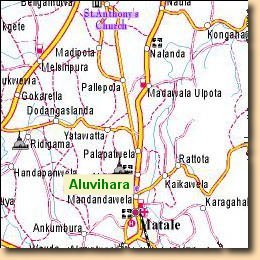
Matale, a market town north of Kandy, received prominence in 1803 with the construction of Fort McDowell by the British during the Kandyan Wars. Situated just north of Matale is Aluvihara Rock Temple. It was here, in the 2nd century BC, that the Buddhist scriptures known as the Tipitika were first committed to writing, a task that required the endeavour of hundreds of monks

Situated just north of Matale is Aluvihara Rock Temple.Aluvihāra is located along the Trincomalee road, a short distance from Mātale town of the Central Province of Sri Lanka. The temple lies 30 km North of Kandy (former capital of Sri Lanka) and 43 km South of Dambulla or the Jumbukola Vihāra, the other temple of equal fame. The driveway climbs toward a mound of massive boulders where the temple nestles. A bas-relief of elephants decorates the compound wall marking the entrance to the Aluvihāra Rock Cave Temple. A mountain range envelops the temple providing breathtaking views of evergreen foliage, making the environment extremely serene and natural.


The cave temple seems to be a result of a primitive massive landslide. Major Forbes describes the rocky setting at Aluvihāra as “Aluewihare (Aluvihāra) rocks, which look as if a portion detached from the great mountain above had been precipitated into the plain, and riven by the shock into those pinnacles and rude masses which are heaped together in so extraordinary a manner.”(Eleven years in Ceylon)
Sir C.M Enxiquez explains the rocky structure at Aluvihāra in his work Ceylon Past and Present (1884) in the following manner. “Alu-wihara (Aluvihāra) (lies)…………, at the foot of a green and mist-swept mountain. Some vast masses of granite have been thrown together,……… Upon a high rock is perched a little white pagoda, and from here you look down among the boulders, as into a chasm. It is a very extraordinary place: for the gaunt and precipitous rocks are now embowered in trees”
In The Ruined cities of Ceylon composed by Sir H.W. Cawe in 1887 illustrates the access to Aluvihāra from the main Trincomalee road as “Just before reaching Mātale we turn aside to the rock temple of Aluwihari(Aluvihāra), which claims our attention both as an extremely picturesque spot and one to which is attached considerable literary interest. We take to a jungle path off the main road till we come upon a flight of stone steps which lead to what appears to have been originally a cleft in the rock.”
Lord Charmers, a Pāli scholar and acting British Governor in Sri Lanka (1913-1916), says with affection “The rocks at Aluvihāra temple are comely gifts given by the nature.”

Home | Significance | Access | History | Artifacts | Contact Us | Appendix I | Appendix II | Appendix III
©1996-2011 Copyright Mahendra Gunaratne, Virus Inc. All Rights Reserved www.virusinc.org virusinc@gmail.com +94 777 783468